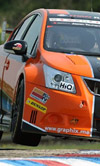BTCC exhausts
 The British Touring Car Championship is in a state of flux at the moment, with cars running to different sets of rules and with different engine regulations in play. As we might expect, no 'side' is happy when the others are winning. It would appear that teams operating under the new rules, with the so-called Next Generation Touring Cars (NGTC) such as the Toyota Avensis campaigned by Dynojet Racing and driven to good effect this year by Frank Wrathall, are becoming more successful, at the expense of teams operating under the more established S2000 rules. Such has been the possibly unexpected success of the NGTC this year that a number of teams are looking to make the change to these rules in 2012, a year earlier than they had originally planned.
The British Touring Car Championship is in a state of flux at the moment, with cars running to different sets of rules and with different engine regulations in play. As we might expect, no 'side' is happy when the others are winning. It would appear that teams operating under the new rules, with the so-called Next Generation Touring Cars (NGTC) such as the Toyota Avensis campaigned by Dynojet Racing and driven to good effect this year by Frank Wrathall, are becoming more successful, at the expense of teams operating under the more established S2000 rules. Such has been the possibly unexpected success of the NGTC this year that a number of teams are looking to make the change to these rules in 2012, a year earlier than they had originally planned.
The NGTC rules allow the use of a 2 litre turbocharged engine in comparison to the naturally aspirated S2000 engines which have been used by the existing entrants. It is easy to imagine that there are going to be lots of differences in the design and manufacture of the exhausts for the cars that compete under the different sets of regulations.
The cars with the NGTC turbocharged engines have to 'hang' a specified turbocharger unit on the primaries of the engine; this is in addition to the fact that there are much higher exhaust gas temperatures for the turbocharged engines. While 'basic' materials would almost certainly suffice for the S2000 cars, it is likely that the turbocharged entrants will have to look to more exotic materials. Certainly stainless steel will be the very minimum specification of material that is likely to prove durable, but it is more likely that high-temperature materials such as Inconel will be the norm. For 2013 and beyond, when all of the cars will be operating to NGTC specifications, there is a planned performance boost from the current 300 hp; this will increase exhaust gas temperatures further.
The efficiency of a turbocharger is affected by the temperature of the incoming flow as it enters the turbine, and the ideal situation (thermodynamically speaking) is for this to be as high as possible. This is one reason why some of the exhausts for the turbocharged NGTC cars are ceramic coated in order to insulate the exhaust and retain heat within the exhaust gas. In the case of the S2000 cars, retention of heat within the exhaust has no engine performance gain.

Exhaust insulation coatings and heat shields might prove effective for both types of engine in protecting adjacent components from the effects of radiated heat. It can also prove worthwhile to prevent radiated heat from reaching the engine or gearbox structure, in order to minimise the heat transfer to coolant.
The design of the S2000 exhausts, with respect to the choice of pipe lengths and diameters, will be driven by the effects this has on the tuning of the engine; the turbocharged NGTC exhausts will be designed with the transient response of the engine in mind. People have found good success with turbocharger response by having the turbo mounted on a short exhaust.
Fig. 1 - British Touring Car racing operates two specifications of engines; turbocharged runners such as this Toyota have different exhaust requirements from the naturally aspirated runners
Written by Wayne Ward